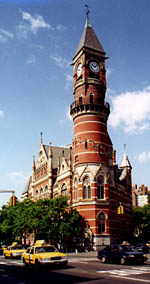Having attended this concert, I was honored to be asked to write an account and reveled in the 4,000-word space they allowed me. What follows is but a brief snipet. You can read the whole piece here, but better yet, buy the CD.
When jazz aficionados ask me, “Johnny who?†I wonder how someone so important in the lives of so many stellar jazz giants could slip beneath their radar. Monty Alexander, Kenny Burrell, Ron Carter, Shirley Horn, Harvey Mason, James Moody, Marlena Shaw, and Phil Woods, who were all on hand, are but a few in a longer list legendary collaborators that also includes Ahmad Jamal, B.B. King, Wes Montgomery, Jimmy Smith, and Joe Williams.
Johnny Pate, mild-mannered and unassuming, has been slipping underneath the radar all his life. But March 30, 2003 is the day he has to face the music – his music – and accept the love and affection of those who have come not only to play his music, but also to say thanks.
The program begins with a proclamation from the Govenor of Nevada celebrating Pate’s musical legacy, and in keeping with his lifetime of accomplishments, the ‘whereas’ clauses go on forever, acknowledging his roles as bassist, songwriter, arranger, producer, teacher, composer and conductor of symphonic and film scores, and mentioning many of the great artists with whom he has worked.
The first of many emotional moments comes when Pate introduces Phil Woods. It may not seem like such a long way from Pennsylvania to Nevada, but for someone battling emphysema and down with the flu just days earlier, it is a very long way indeed. Still, Woods would not have missed today’s events. He tells the audience about his life as a struggling musician in the 1960s. “I couldn’t get arrested. ‘Buy a flute, be a studio man,’ they told me. I said ‘forget it.’†Woods moved to Europe . Tracking him down in France, Pate offered Woods a record deal with a dream rhythm section (Herbie Hancock on piano, Richard Davis on bass and Grady Tate on drums), augmented by a string section led by Gene Orloff. The album is titled Round Trip. “I’m talking the truth,†Woods tells us. “I went back to France with a shitload of money, and a few months later I was invited to play at Newport. I was back, baby! I was back, and that’s ’cause of Johnny Pate, and I want to say thank you.â€
One by one, these featured artists augment the UNLV Jazz Band. By the time Monty Alexander, Ron Carter and Harvey Mason finish driving the band through the blues, the audience is cheering and we haven’t even reached intermission yet. “I promise you we won’t play anymore lullabies,†quips Pate. “It’s smoking up here.â€
Johnny voice cracks more than once with unshed tears – when introducing Phil Woods, when Shirley Horn emerges from the wings in her wheelchair and procedes to play piano for the first time in public using a prosthesis in place of her amputated leg, and when he speaks of his dear friend Joe Williams, no longer with us.
The show is over all too soon. After the encore, the applause begins to die down, but not because the audience is ready to leave. Applause gives way to a spontaneous audience rendition of “Happy Birthday, dear Johnny, Happy Birthday to you.†They know his birthday is actually nine months away, but it doesn’t matter.
No one could be immune to the outpouring of love and appreciation that filled the theater. It’s just ten days since America invaded Iraq and people are still glued to the news reports, but for a few hours at least, all of that was put from our minds. Ten days after the concert, columnist John L. Smith writes in the Las Vegas Review-Journal, “…I found myself not thinking about war,†and he thanks Pate “for reminding us of the beauty that is still in the world.†I like to think he speaks for everyone who hears this live commemorative recording.

